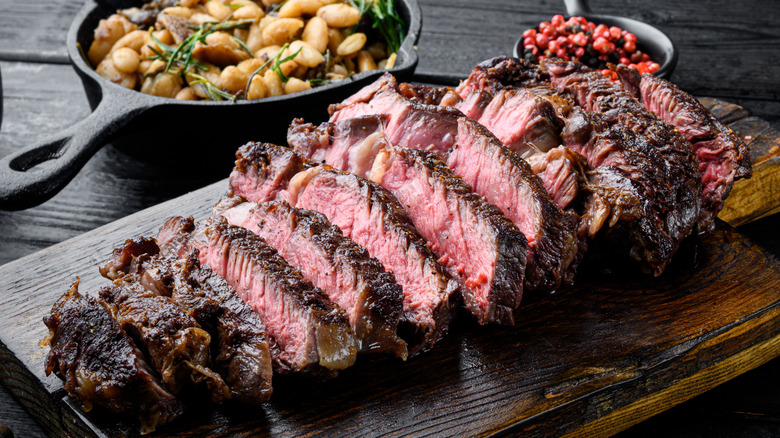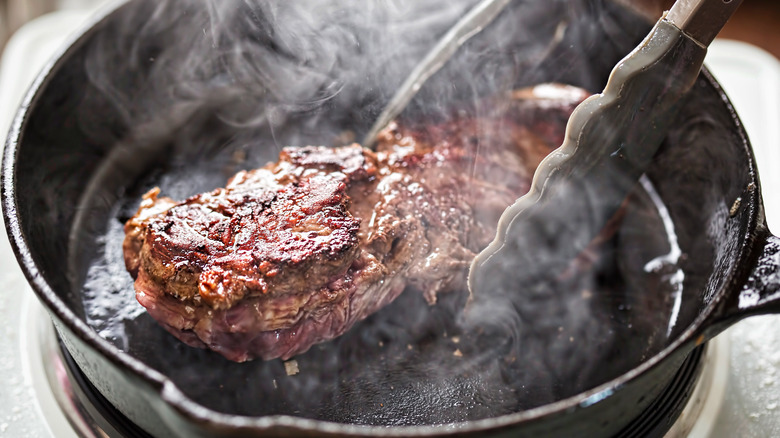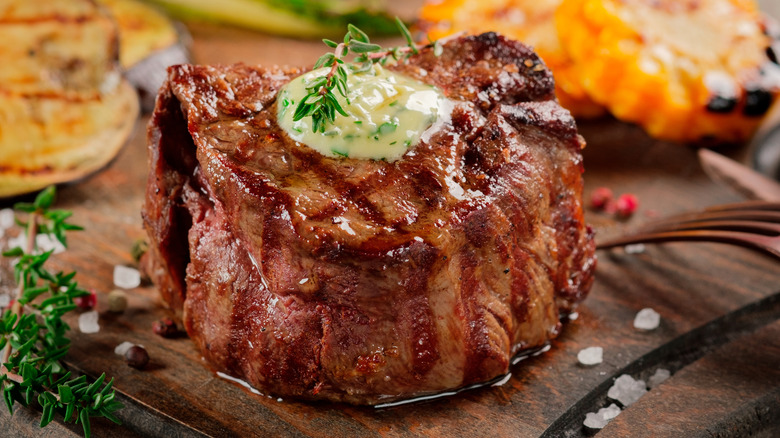If You Sear Your Steak In A Cast Iron, Leave Off The Dried Herbs
The deliciousness of a good, seared steak is a forever thing — regardless of whether it's grilling season. A trusty cast-iron skillet, and little practice, and you'll be cooking your ribeye steak like a pro. Apart from all the other how-to stuff about thoroughly drying the steak and the application of high heat, there's one other pro tip you need to know about the frankly magical combination of cow and cast iron: Forget about using dried herbs as part of your seasoning strategy; they're just gonna burn.
This is not to say that you're somehow limited by this steak-cooking method; far from it. You'll still be able to plumb the depths of creativity and achieve the heights of deliciousness by pan-searing a steak; the only trick is to keep the seasonings simple while the cooking part is happening. It's in the finishing and topping stage that some really cool stuff can happen, and this absolutely includes the use of herbs — and fresh ones at that, which impart a purer taste.
It's getting hot in here, so take off all your herbs
Apart from their primitive, artisanal appeal, cast iron skillets are ideal for cooking steak because they can achieve — and maintain — a really high temperature. Why does that matter? Because of the Maillard Reaction, something every cook needs to understand. Referred to in dry, scientific terms as a non-enzymatic browning reaction, the Maillard Reaction is a series of chemical reactions involving the interaction between amino acids, reducing sugars, and high heat. Put another way, most of the things you love about a well-seared steak: The gorgeous aroma, the deeply browned exterior, the slightly crisp almost caramelized crust — that's all thanks for the Maillard Reaction.
So, you'll need to be rockin' the heat on your cast iron — functionally to grilling temperatures, just below the smoke point of the (neutral, high smoke point) oil you're using; say about 500 degrees Fahrenheit for something like avocado oil. With these temperatures, coating your beautiful New York strip with little flakes of dried thyme won't set your dinner up for success. Forget finely ground spices, too — they'll simply become a carbon coating. So, what does your steak need, besides being thoroughly dried? A simple, generous coating of coarse salt and cracked black pepper. Then it's time to sear that sucker.
Wait, when do the herbs come in?
Once the initial searing is done, and about a minute before the steaks are fully cooked, it's time to start basting. A canny home cook knows to baste a steak in the process of cooking it. A time-tested baste consists of a generous pat of sweet butter, a few cloves of peeled, crushed garlic, and a few sprigs of fresh thyme. The butter will melt and clarify, adding a gorgeous nuttiness, the garlic will bring both savory and sweet, and the thyme will infuse everything with herbaceousness. Tilt the cast iron skillet and use a large spoon to flick the basting liquid over the top of the searing steak until it's time to take it out of the pan.
If basting isn't your thing, you've still got herb options to dress up your cast iron skillet steak. Consider topping it with a large dollop of fresh herb butter, made with garlic, thyme, sage, parsley, and rosemary (or any combination thereof) when serving. That will bring a cleaner sweetness and herbal bite to the finished steak than the butter-and-herb baste. It's not only cool to use herbs with a skillet-cooked steak — it's culinary genius, and only a question of how and when, not if. Now, go explore the wonderful world of cast-iron cookware.


